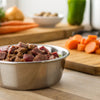Understanding What is Raw Coated Dog Food: A Comprehensive Guide
- Houndsy
Table of Contents
- Introduction
- What is Raw Coated Dog Food?
- Benefits of Raw Coated Dog Food
- Risks and Considerations
- Integrating Raw Coated Dog Food into Your Pet's Diet
- Conclusion
Introduction
Did you know that nearly 1 in 5 pet owners are considering switching their dog's diet to a raw or raw-coated option? The surge in pet food trends has pet parents more curious than ever about what goes into their furry friends’ meals. One of the standout options emerging from this curiosity is raw coated dog food, a uniquely irresistible blend of traditional kibble and the nutrient-rich benefits of raw food.
As we navigate the world of pet care, understanding our companions' nutritional needs becomes essential for promoting their health and well-being. Raw coated dog food transcends the limitations of conventional kibble by infusing raw meat proteins directly into the mix, potentially offering better palatability and added nutrition. In this blog post, we will explore what raw coated dog food is, how it’s made, its benefits and risks, and why it can be a beneficial choice for pet parents looking to enhance their dogs' dining experience.
By the end of this article, we want you to feel informed and equipped to make the best decisions for your beloved companion. Let’s dive into this compelling topic and consider how raw coated dog food might fit into your pet feeding routine.
What is Raw Coated Dog Food?
Raw coated dog food refers to dry kibble that has been coated with a layer of freeze-dried raw meat, providing an appealing flavor and texture for dogs. This innovative approach brings together two contrasting feeding philosophies: the convenience and stability of kibble and the natural, nutritious qualities of raw food. While traditional kibble may lack in taste or freshness, the inclusion of raw proteins aims to address those shortcomings significantly.
The transition to raw coated food can be likened to offering a gourmet twist to everyday meals. By introducing raw meat—an ingredient much adored in canine diets—raw coated kibble can elevate the eating experience, making meals more enjoyable for even the pickiest of eaters.
The Process of Creating Raw Coated Dog Food
Creating raw coated dog food typically involves several key steps:
-
Selection of Protein: The first step involves choosing the appropriate raw protein source, commonly beef, chicken, or fish. These proteins are essential for maintaining muscle health and supporting your dog's energy levels.
-
Freeze Drying: Once selected, the raw meat is carefully freeze-dried, removing moisture while preserving its nutritional content. This process enhances shelf-life and protects against spoilage.
-
Crushing and Coating: After freeze-drying, the meat is ground into a fine powder and used to coat each piece of kibble. This can be done using various techniques, including lipid adhesives to ensure an even coating.
-
Drying and Packaging: The coated kibble may undergo additional drying to achieve the desired texture and preserve freshness, after which it is packaged for consumers.
By understanding the manufacturing process, we can appreciate the effort put into creating a product that merges the taste and nutritional benefits of raw food with the familiar texture of kibble.
Benefits of Raw Coated Dog Food
Raw coated dog food presents several advantages that can significantly impact your pet's overall health and happiness:
Enhanced Palatability
Pets often have a discerning palate, and many canines prefer foods with strong flavors and aromas. Raw coated kibble typically provides heightened levels of protein and fat, creating a more enticing meal that dogs are likely to consume eagerly. The freshness and aroma of raw food can encourage even the most selective eaters to enjoy their meals.
Nutritional Benefits
One of the significant upsides to raw coated kibble is its nutrient profile. The presence of high-quality, freeze-dried raw proteins can enhance the overall nutritional balance, offering essential amino acids vital for muscle maintenance, energy production, and immune function. Moreover, most raw coated diets are formulated with vitamins and minerals, ensuring that they meet the nutritional requirements set by the Association of American Feed Control Officials (AAFCO).
Digestive Health
Raw coated diets often include natural prebiotics and probiotics that support healthy digestion. These components can aid in establishing a balanced gut microbiome, reducing the incidence of digestive issues like bloating or diarrhea. Maintaining a healthy digestive environment is essential for your dog's nutrient absorption and overall well-being.
Quality of Ingredients
Raw coated dog food typically emphasizes quality sourcing and processing. Most brands declare their commitment to responsible sourcing, ensuring that the proteins used are free from by-products, hormones, and antibiotics. This focus on high-quality ingredients aligns with the values many pet owners hold dear when choosing food for their furry companions.
Risks and Considerations
While raw coated dog food offers a delightful alternative to traditional kibble, it’s crucial to be aware of potential risks:
Microbial Contamination
One of the primary concerns regarding raw food—coated or otherwise—is the presence of harmful bacteria such as Salmonella or E. coli. Despite freeze-drying significantly reducing moisture and making it less hospitable for pathogens, it does not eliminate all bacteria. Consequently, handling and serving raw-coated kibble requires diligent hygiene practices to mitigate risks associated with microbial contamination.
Nutritional Imbalances
While raw coated kibble is generally more nutritionally balanced than an all-raw diet, there's still the risk that the freeze-drying process might impact certain nutrients. We should remain aware that while the benefits are notable, an unbalanced diet lacking specific vitamins or minerals may lead to nutritional deficiencies over prolonged periods.
Cost Factor
Raw coated diets can be relatively higher in price compared to standard kibble. Pet owners need to consider their budget within the context of the overall dietary needs of their dog before transitioning to raw-coated products.
Allergies and Sensitivities
As with any dog food, there is always the potential for food sensitivities or allergies. It’s critical to start any new diet slowly and monitor your pet closely for any signs of adverse reactions.
Integrating Raw Coated Dog Food into Your Pet's Diet
When considering your dog's transition to raw coated dog food, we recommend following these steps to ensure a smooth shift.
Consult a Veterinarian
Always consult with your veterinarian before making significant changes to your pet's diet. They can offer personalized guidance according to your dog's age, breed, health conditions, and specific dietary needs.
Gradual Transition
Changing your pet's food abruptly can result in digestive upset. Instead, we suggest slowly introducing raw coated kibble over 7-10 days. Start by mixing a small amount of the new kibble with their existing food and gradually increase the proportion while decreasing the old diet.
Monitor Health Indicators
Throughout the transition process, be vigilant about observing your dog for any changes in their behavior, digestion, energy levels, or overall health. Keeping a log can be helpful in identifying how they are adapting to their new diet.
Conclusion
In conclusion, raw coated dog food offers a compelling option for pet parents wanting to enhance their dog's diet while providing the convenience of kibble. By understanding the benefits and potential risks, we can make more informed choices that promote our furry friends’ health.
Recommendations for a healthy feeding routine include exploring high-quality options like the Houndsy Kibble Dispenser, which enhances the feeding experience with ergonomic design and portion control. With thoughtful consideration, we can elevate the dining experience of our beloved companions and contribute to their overall well-being.
FAQ
1. Is raw coated dog food safe for all dogs?
Generally, raw coated dog food is safe for most dogs. However, it is essential to consider individual allergies and consult your veterinarian prior to introducing any new diet.
2. How do raw coated diets compare nutritionally to regular kibble?
Raw coated diets often provide enhanced protein and fat content, along with the nutritional benefits of freeze-dried raw food. This makes them more palatable and potentially more nutritious than standard kibble.
3. What are the best practices for handling raw coated food?
Always wash your hands after handling raw-coated dog food, clean feeding bowls thoroughly, and ensure to store the food according to package instructions to maintain freshness and safety.
4. Can I mix raw coated kibble with wet food?
Yes, many pet owners choose to mix raw coated kibble with wet food for added moisture, flavor, and variety in their dog's diet.
5. How can I monitor my dog’s reaction to a new diet?
Observe your dog for any changes in behavior, digestion, and energy levels after transitioning to a new diet. Keeping a record can help identify any issues that may arise during this period.
By embracing the unique benefits of raw coated dog food, coupled with innovative feeding solutions like the Houndsy Kibble Dispenser, we can provide an enjoyable and healthful dining experience that our canine companions truly deserve.












